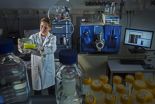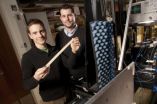(Press-News.org) Gas separation is crucial for many industrial processes including obtaining nitrogen or oxygen from air and purifying natural gas or hydrogen. Currently, the most energy efficient method for separating gases involves polymer membranes, however, most polymers either let gases pass through slowly (i.e. have low permeability) or are not selective towards one gas over another. Gas separation would be cheaper and use less energy if polymer membranes could be made both highly permeable and selective.
A team from the University's School of Chemistry reports in the journal Science a new polymer that efficiently separates gas mixtures based on the different sizes of the gas molecules. The polymer's molecular structure is very contorted so that it cannot fill space efficiently, therefore leaving gaps for small gas molecules to move through quickly. However, the transport of larger gas molecules is hindered by the polymer's extreme rigidity so that it acts as an efficient molecular sieve.
The Cardiff's team's collaborators at the Institute on Membrane Technology, ITM-CNR, Italy, confirmed that membranes prepared from the polymer are both highly permeable to gases and demonstrate remarkable selectivity for smaller gases such as hydrogen or oxygen over larger gases such as nitrogen or methane.
Professor Neil McKeown, a member of the School of Chemistry's team behind the research said: "The preparation of this highly rigid and contorted polymer required us to develop a new polymerisation reaction. In fact we used some very old chemistry – the formation of Tröger's base, which is a compound that was first prepared 125 years ago. This simple chemistry allows us to prepare highly rigid ladder polymers of high molecular mass from readily available starting materials. In addition to making polymers for efficient gas separation membranes, we anticipate that this new process will be useful for preparing polymers for a variety of different applications".
Cardiff University has applied for a patent covering this new polymerisation process.
### Notes to editors
Cardiff University is recognised in independent government assessments as one of Britain's leading teaching and research universities and is a member of the Russell Group of the UK's most research intensive universities. Among its academic staff are two Nobel Laureates, including the winner of the 2007 Nobel Prize for Medicine, University President Professor Sir Martin Evans.
Founded by Royal Charter in 1883, today the University combines impressive modern facilities and a dynamic approach to teaching and research. The University's breadth of expertise in research and research-led teaching encompasses: the humanities; the natural, physical, health, life and social sciences; engineering and technology; preparation for a wide range of professions; and a longstanding commitment to lifelong learning. Three major new Research Institutes, offering radical new approaches to neurosciences and mental health, cancer stem cells and sustainable places were announced by the University in 2010. www.cardiff.ac.uk
For further information: Victoria Dando, Public Relations, Cardiff University, Tel: 02920 879074; email: dandov2@cardiff.ac.uk
Separating gases using a rigid polymer sieve
More efficient gas separations can be achieved using a new polymer that selectively sieves gas molecules
2013-01-18
ELSE PRESS RELEASES FROM THIS DATE:
GI tract bacteria may protect against autoimmune disease
2013-01-18
This press release is available in German.
Toronto -- Early life exposure to normal bacteria of the GI tract (gut microbes) protects against autoimmune disease in mice, according to research published on-line in the January 17 edition of Science. The study may also have uncovered reasons why females are at greater risk of autoimmune diseases such as multiple sclerosis, rheumatoid arthritis, and lupus compared to males.
Researchers from The Hospital for Sick Children (SickKids) found that when female mice at high risk of autoimmune (type 1) diabetes were exposed ...
U Alberta researchers move Barkhausen Effect forward
2013-01-18
(Edmonton) Almost 100 years after the initial discovery, a team of scientists at the University of Alberta and the National Institute for Nanotechnology in Edmonton have harnessed the Barkhausen Effect as a new kind of high-resolution microscopy for the insides of magnetic materials.
The researchers say the technique has the potential to provide critical information as a rapid prototyper for magnetic computational devices that expand the role of magnetism within computers.
In 1919, Barkhausen discovered the first evidence of magnetic domains (patterns in how the directions ...
Doubling down on energy efficiency
2013-01-18
Spending on energy efficiency programs funded by electric and natural gas utility customers will double by 2025 to about $9.5 billion per year, according to projections published today by researchers at Lawrence Berkeley National Laboratory (Berkeley Lab).
These funds, which come from a charge on utility bills, historically constitute the nation's largest source of spending on programs to foster the adoption of more efficient products and buildings. According to the Berkeley Lab report, energy efficiency programs funded by utility customers are projected to continue ...
Novel sensor provides bigger picture
2013-01-18
DURHAM, N.C. – Duke University engineers have developed a novel sensor that is more efficient, versatile and cheaper for potential use in such applications as airport security scanners and collision avoidance systems for aircraft, cars or maritime vessels.
The researchers fabricated a unique material, known as a metamaterial, that acts as a lens to image scenes using fewer components than conventional detectors. Because of the properties of this man-made material, much of the additional equipment needed for conventional detector systems – like lenses, mechanical positioners ...
Irregular heart beat elevates risk of kidney failure
2013-01-18
Many people who suffer from chronic kidney disease progressively lose their kidney function over time and eventually develop a condition called end-stage renal disease – the complete failure of the kidneys – placing them in need of lifelong dialysis or a kidney transplant.
Now researchers at the University of California, San Francisco (UCSF) and the Kaiser Permanente Northern California Division of Research have found that the risk of kidney failure is greater for people with chronic kidney disease who also have atrial fibrillation, one of the most common forms of irregular ...
Power's punishing impact
2013-01-18
Often, employees are shocked by what they think is a supervisor's severe reaction to a subordinate's seemingly minor transgression. The supervisors who punish them seem to be so absolutely sure that they are doing the right thing—they have a clear sense of purpose and there are no arguments to sway them.
New research by Scott Wiltermuth, a USC Marshall School of Business assistant professor of management and organization, and co-author Francis Flynn of the Stanford Graduate School of Business, found that providing a sense of power to someone instills a black-and-white ...
Mayo Clinic researchers identify enzyme involved in deadly brain tumors
2013-01-18
ROCHESTER, Minn. -- One of the most common types of brain tumors in adults, glioblastoma multiforme, is one of the most devastating. Even with recent advances in surgery, radiation and chemotherapy, the aggressive and invasive tumors become resistant to treatment, and median survival of patients is only about 15 months. In a study published in Neuro-Oncology, researchers at Mayo Clinic identify an important association between the naturally occurring enzyme Kallikrein 6, also known as KLK6, and the malignant tumors.
"Our study of Kallikrein 6 showed that higher levels ...
Botox beats steroids for painful foot condition, plantar fasciitis
2013-01-18
Los Angeles, CA (January 17, 2013) - Plantar fasciitis is the most frequent cause of chronic heel pain, leaving many sufferers unable to put their best foot forward for months at a time. Now a Mexican study suggests that physicians should turn to Botox rather than steroids to offer patients the fastest road to recovery. The research appears in the journal Foot & Ankle International, published by SAGE.
Plantar fasciitis results when connective tissues on the sole of the foot, the plantar fascia, become painfully inflamed. Physicians may suggest various therapies for this ...
Questions about biosafety? Ask a biosafety expert
2013-01-18
WASHINGTON— The rapid decline in costs associated with many common laboratory techniques, such as DNA sequencing and synthesis, has led to their adoption by individuals outside of traditional university or industrial settings, giving rise to a rapidly growing Do-It-Yourself Biology (DIYbio) community.
DIYbio.org and the Synthetic Biology Project at the Woodrow Wilson Center this week are launching the "Ask a Biosafety Expert" service in order to provide this emerging DIYbio community with free and timely access to professional biosafety advice. The project comes amidst ...
Why wolves are forever wild, but dogs can be tamed
2013-01-18
AMHERST, Mass. – Dogs and wolves are genetically so similar, it's been difficult for biologists to understand why wolves remain fiercely wild, while dogs can gladly become "man's best friend." Now, doctoral research by evolutionary biologist Kathryn Lord at the University of Massachusetts Amherst suggests the different behaviors are related to the animals' earliest sensory experiences and the critical period of socialization. Details appear in the current issue of Ethology.
Until now, little was known about sensory development in wolf pups, and assumptions were usually ...
LAST 30 PRESS RELEASES:
Injectable breast ‘implant’ offers alternative to traditional surgeries
Neuroscientists devise formulas to measure multilingualism
New prostate cancer trial seeks to reduce toxicity without sacrificing efficacy
Geometry shapes life
A CRISPR screen reveals many previously unrecognized genes required for brain development and a new neurodevelopmental disorder
Hot flush treatment has anti-breast cancer activity, study finds
Securing AI systems against growing cybersecurity threats
Longest observation of an active solar region
Why nail-biting, procrastination and other self-sabotaging behaviors are rooted in survival instincts
Regional variations in mechanical properties of porcine leptomeninges
Artificial empathy in therapy and healthcare: advancements in interpersonal interaction technologies
Why some brains switch gears more efficiently than others
UVA’s Jundong Li wins ICDM’S 2025 Tao Li Award for data mining, machine learning
UVA’s low-power, high-performance computer power player Mircea Stan earns National Academy of Inventors fellowship
Not playing by the rules: USU researcher explores filamentous algae dynamics in rivers
Do our body clocks influence our risk of dementia?
Anthropologists offer new evidence of bipedalism in long-debated fossil discovery
Safer receipt paper from wood
Dosage-sensitive genes suggest no whole-genome duplications in ancestral angiosperm
First ancient human herpesvirus genomes document their deep history with humans
Why Some Bacteria Survive Antibiotics and How to Stop Them - New study reveals that bacteria can survive antibiotic treatment through two fundamentally different “shutdown modes”
UCLA study links scar healing to dangerous placenta condition
CHANGE-seq-BE finds off-target changes in the genome from base editors
The Journal of Nuclear Medicine Ahead-of-Print Tip Sheet: January 2, 2026
Delayed or absent first dose of measles, mumps, and rubella vaccination
Trends in US preterm birth rates by household income and race and ethnicity
Study identifies potential biomarker linked to progression and brain inflammation in multiple sclerosis
Many mothers in Norway do not show up for postnatal check-ups
Researchers want to find out why quick clay is so unstable
Superradiant spins show teamwork at the quantum scale
[Press-News.org] Separating gases using a rigid polymer sieveMore efficient gas separations can be achieved using a new polymer that selectively sieves gas molecules




